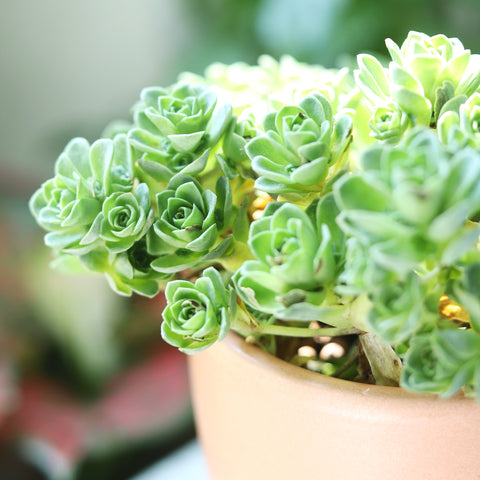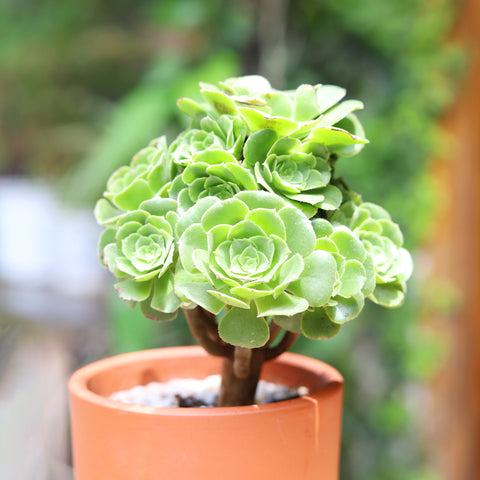Rosularia Platyphylla is a succulent plant belonging to the Crassulaceae family, which includes other well-known succulents like Sedum and Echeveria. Also known as Turkish stonecrop, this hardy plant is native to the mountainous terrains of Turkey. The "stonecrop" name is often used for plants within the Crassulaceae family due to their ability to grow in stony, seemingly inhospitable places with little soil.
The genus name "Rosularia" is derived from the Latin word "rosula," meaning "small rose," which refers to the rosette shape formed by the leaves of these plants. The species name "Platyphylla" comes from Greek roots: "platys," meaning broad or flat, and "phyllon," meaning leaf, indicating this plant's characteristic broad, flat leaves.
This perennial succulent forms tight rosettes of fleshy, spoon-shaped leaves that are green to gray-green in color. The leaves may have a slight red tinge along their margins when exposed to bright sunlight or during cooler temperatures. Rosularia Platyphylla is a relatively small, slow-growing succulent that typically reaches a maximum height of about 6 to 8 inches and can spread outwards to approximately the same width. It forms compact rosettes that may gradually spread over time as offsets are produced.
Rosularia Platyphylla produces tall flower stalks bearing clusters of small, star-shaped flowers that are typically white or pale pink. Its small size, attractive rosettes, and easy-care nature make it a favored choice for table tops, small indoor spaces, and succulent arrangements, as well as rock gardens.
Toxicity
Rosularia Platyphylla, like many members of the Crassulaceae family, is generally considered non-toxic to humans and pets. This makes it a safe choice for households with children and animals who might be curious about the plants in their environment. However, as with any plant, it's always prudent to discourage pets and young children from ingesting plant material. While Rosularia Platyphylla may not be toxic, consuming parts of any plant could potentially cause mild stomach upset or an allergic reaction in sensitive individuals or pets.
General Care
Lighting
Rosularia Platyphylla thrives in conditions with plenty of bright, filtered light. If you're growing it outdoors, a spot that receives several hours of gentle morning sunlight followed by partial shade in the afternoon is ideal, especially in hotter climates where intense midday sun might be too harsh.
When grown indoors, place your Rosularia Platyphylla near a window that gets lots of bright, indirect light throughout the day. South-facing windows are usually a good choice for succulents. If natural light is limited, consider using grow lights to supplement the plant's light needs. In spring, after a long dark winter, or when you move your plant from a lower light condition to a brighter spot, acclimate it gradually over several days or weeks. This will help prevent sunburn on the leaves, which can occur if the plant is suddenly exposed to intense sunlight.

Rosularia Platyphylla thrives in conditions with plenty of bright, filtered light.
Watering
Rosularia Platyphylla, like most succulents, has modest watering requirements due to its ability to store water in its leaves. Allow the soil to dry out completely between waterings. Check the soil's moisture level before each watering by inserting a finger an inch deep into the soil or using a moisture meter. If there's any dampness, wait a few more days before checking again. Water thoroughly and let all excess water drains out of the pot's bottom. This ensures that the roots receive adequate moisture without becoming waterlogged. During the active growing season in spring and summer, Rosularia Platyphylla may need more frequent watering to support growth. Reduce watering significantly during the dormancy in the cold months.
Soil and Fertilizer
Rosularia Platyphylla requires a soil mix that provides excellent drainage to prevent water retention and potential root rot. A commercial cactus or succulent potting mix is ideal as it typically contains a blend of ingredients like sand, perlite, or pumice that promote good drainage. If you prefer to make your own mix, combine regular potting soil with coarse sand. Steer clear of soils that are too dense or clay-heavy as they can retain moisture and lead to root rot.
Rosularia Platyphylla does not require heavy fertilization. During the growing season (spring and summer), you can feed the plant with a diluted, balanced fertilizer once every 2 to 4 weeks. Use a water-soluble fertilizer at half the recommended strength to avoid over-fertilizing, which can harm the plant. Stop fertilizing during the fall and winter months when the plant's growth naturally slows down.
Temperature and Humidity
Rosularia Platyphylla thrives in temperatures between 60°F and 80°F. It can tolerate higher temperatures as long as it's not exposed to prolonged direct midday sun, which could cause heat stress. This succulent can withstand cooler temperatures to around 40°F and even some frost. However, prolonged exposure to freezing temperatures or severe frost can damage your plant.

Rosularia Platyphylla can withstand cooler temperatures to around 40°F and even some frost.
Rosularia Platyphylla prefers dry air and may struggle in high-humidity environments (humidity level of over 50%) where it's more susceptible to rot and fungal diseases. If grown indoors, ensure good air circulation around the plant to help keep the humidity levels down.
Potting and Repotting
It is important to plant your Rosularia platyphylla in a suitable pot, ideally made from a porous material like cement, ceramic or terracotta. The pot should have at least one drainage hole to facilitate optimum drainage.
Repotting should ideally be done every 2-3 years during the plant's active growing season, which is in the spring or early summer. Carefully remove the plant from its old pot, and inspect the roots for health. Choose a new pot that is only one size bigger than the original one. After repotting, wait a few days before watering to allow any disturbed roots to recover, minimizing stress and reducing the risk of root rot.
Pruning
Pruning helps to maintain the plant's shape and remove any dead or damaged leaves. As a slow-growing succulent, Rosularia Platyphylla rarely requires extensive pruning. Use clean, sharp scissors or pruning shears to snip away any unsightly or unhealthy foliage, taking care not to damage the healthy rosettes. This gentle tidying up can be done at any time of year but is best performed during the growing season when the plant can quickly recover. Pruning also provides an opportunity to propagate new plants from healthy cuttings.
Propagation
Propagating Rosularia platyphylla is a rewarding and straightforward process that can be achieved through leaf cuttings or offsets.
With leaf cuttings
- Select a healthy, mature leaf from the Rosularia Platyphylla plant
- Gently twist the leaf off to ensure a clean removal without leaving any part on the stem
- Allow the leaf cutting to dry for several days in a warm, dry place away from direct sunlight until a callus forms on the cut end
- Place the callused leaf on top of a well-draining cactus or succulent potting mix, either laying flat or with the cut end slightly inserted into the soil.
- Position the potted leaf cutting in bright, indirect light
- Water sparingly to maintain barely moist soil without making it wet.
- Wait for roots to develop and a new rosette to form at the base of the cutting; this may take weeks to months
- Once established with a strong root system and new growth, transplant into its own pot for continued care and growth.

Propagating Rosularia platyphylla is a rewarding and straightforward process that can be achieved through leaf cuttings or offsets.
With offsets
- Gently separate the offset from the mother plant using a clean, sharp knife or scissors, ensuring each offset has some roots attached
- Allow the separated offsets to dry for a few days in a warm, dry place until the cut surfaces form calluses
- Prepare pots with well-draining cactus or succulent potting mix for planting the offsets
- Plant each callused offset in its own pot, burying it just deep enough to stand upright and stabilize in the soil
- Position the newly potted offsets in bright, indirect light away from direct sunlight to avoid scorching
- Water sparingly after planting to encourage root growth without causing rot; let soil dry out between waterings
- Monitor for new growth as an indication that the offset has successfully taken root and is establishing itself
- Once established and showing signs of growth, care for them as you would a mature Rosularia Platyphylla.
Common Problems
- Overwatering: The most common issue, leading to root rot and fungal infections. Signs include yellowing leaves, a mushy base, or black spots on leaves.
- Pests: Aphids, mealybugs, and spider mites may infest the plant, causing damage by sucking sap from the leaves.
- Sunburn: Excessive direct sunlight can scorch the leaves, resulting in white or brown burn marks.
- Cold Damage: Not all Rosularia species are frost-tolerant; cold damage appears as soft, discolored areas on the plant.
- Physical Damage: Rough handling can break delicate leaves and stems. Handle with care during repotting or pruning.




































































































